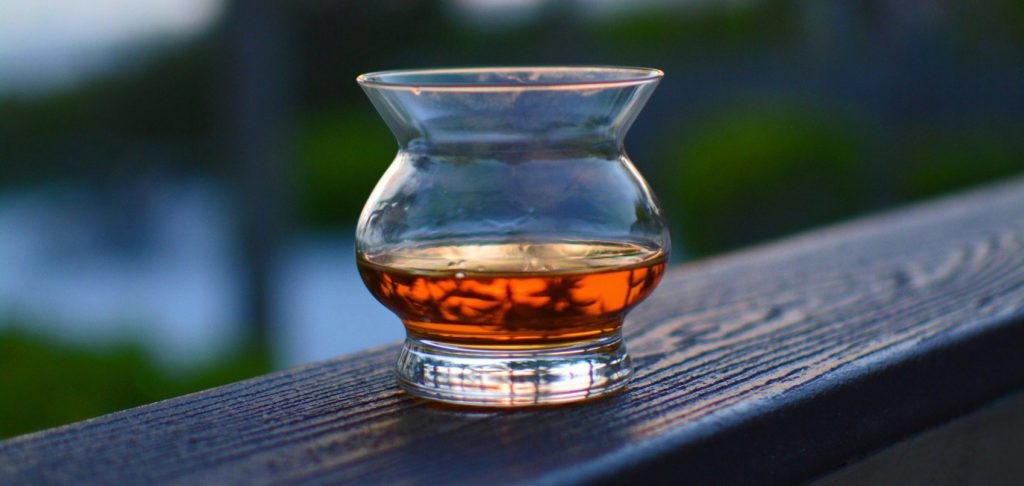

Getting Useful Sensory Results from Whiskey Evaluations
George F Manska, CR&D Arsilica, Inc.
Part 1 – The Rise of the Tulip
Which glass is best for serious whiskey drinkers? It’s complicated, so we’ve segmented the story; Part 1, Rise of the Tulip, Part 2 Ethanol Effects on Sensory Perception, and Part 3, Modern Science Changes the Way the World Drinks. Part 1 follows:
Late 1700s: Sherry trade flourishes. Spanish copita (tulip glass) becomes the “dock glass” for merchants to verify sherry quality on the wharf before shipping. Hogsheads arrive in Great Britain for bottling, branding, and resale throughout the world. Sherry, along with the copita/tulip glass becomes the preferred drink of the upper/middle class and the libation of choice for social and business gatherings worldwide through the late 1900s. Tulip is adopted for non-fortified table wines. It is here that the complacency with the tulip begins.
An Icon is Born: Scotch distillers promote tulips because; (1) size is small enough to hold an ample serving of high ABV spirits – about 1 ½ oz. (2) existing design, no new product necessary, (3) sherry and wine drinkers have them, glassware shortage or acceptance is not a barrier to scotch sales. Scotch achieves popularity worldwide as a “deal-sealer drink” in business as well as a status symbol for the well-to-do. Scotch is so popular that distillers in India, Japan, the USA, and many other countries try their hand at re-creating it, concurrently adopting tulips as their preferred glass.
1960s: Scotch distillers recognize the fact that Americans don’t drink spirits straight, and neat (no mixers, ice, or water). Prohibition unleashes a black market of illegal, dangerous, incompetent distillery products upon the population, and the cocktail is born, using fruit juice, ice, water, and soda, to hide foul head and tail cuts and disguise poisonous compounds. The American concept of drinking straight spirits is “unrefined, skid-row bum, dangerous.” Americans develop a strong aversion to pungent ethanol. Therefore, the cocktail becomes almost a necessity to fill a desired respectable image.
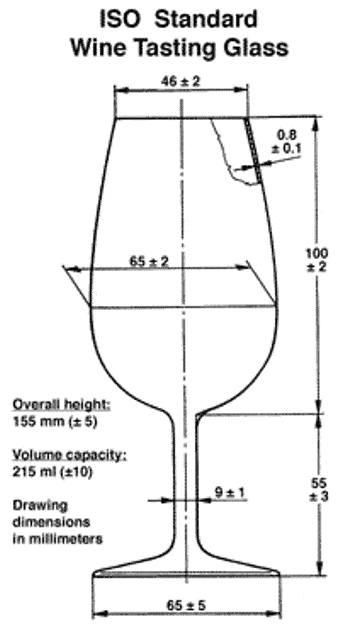
The European/UK nose travels a different path. European bars have no ice, cocktails are unheard of, and straight spirit consumption is a way of life as is the tiny-rim tulip.
1970-2010: As scotch marketers soon realize pungent ethanol is a barrier to American scotch sales, procedures to acclimate to tulip-concentrated ethanol are taught: (1) don’t swirl, (2) breathe through mouth and nose simultaneously, (3) add a little water, (4) don’t smell ortho-nasally, (5) repeatedly waft aromas toward nose as glass approaches to acclimate. Efforts pay off, as scotch and tulips gain acceptability. As a result, acclimation becomes the viable solution to the problem of strong, pungent ethanol.
1977: the International Standards Organization issues ISO 3591 Standard – Sensory Analysis Apparatus – Wine Tasting Glass. Nearly an exact copita copy, it’s the only drinking vessel standardized by ISO. Manufacturers, noting similarity to the well-known scotch copita decided to twist the application to improve sales and name it the ISO whiskey glass.
2000-Present: WSET, International Court of Sommeliers, and many sommelier training programs mistakenly designate their recommended spirits tasting glass as an ISO whiskey glass. Not a single “peep” from ISO is heard. To clarify, no one seems particularly interested in anything besides tradition, and for certain, science is not a remote consideration. Certainly, industry educators are failing us.
1980-Present: Glassmakers attempt to penetrate markets with fresh whisky glass styling, yet changes are minor. Bowl heights and diameters remain similar to copita for fear of rejection by the spirits industry or consumers. Blindfolded, no one can discern aroma delivery differences between common tulip styles; all concentrate pungent, nose-numbing ethanol. Scotch drinkers everywhere favor tulips because distillers’ blenders (the professionals) use them.

2001: Raymond Davidson, in a stroke of marketing genius, introduces the Glencairn tulip derivative, endorsed by master blenders of the five largest whisky companies in Scotland, and wins the Queen’s Award for International Enterprise.
2023 Present State of the Art: Glencairn is now the iconic identity badge and embodiment of tradition for whisk(e)y drinkers globally, and quickly becoming popular for other spirits. Glencairn is a superb textbook example of well-executed marketing, resulting in overwhelming worldwide acceptance.
Scientific research doesn’t find its way into commercial product design easily or rapidly. The closed scientific journal community continually discovers/publishes new information, and the sensory science field has expanded rapidly in the last 20 years; yet scientific aspects of how we smell, taste, and process flavors are slowly coming to public light. However, as sensory science is recognized, necessary changes eventually become apparent.
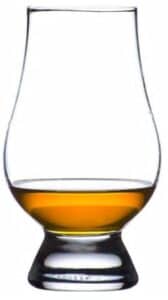
Tulip Science Prior to Sensory Science: “Science” is invented to fit a tulip shape. Difficult questions create hasty, over-simplified answers that defy science.
- Q: “Why are tulip rims so small?” A: “Small rims collect all aromas so none can escape detection.” NOTE: 40%+ of all molecules at the tulip’s rim are pungent, nose-numbing ethanol.
- Q: “Why is it so pungent?” A: “Ethanol can’t be separated, live with it, drinking procedures help to get used to it.”
As a result, whiskey drinkers “drink and know things” after many decades of worldwide tulip use, and science is not about to get in the way and upset tradition, even if it’s right. Many false, yet commonly accepted beliefs pull us down a path to risky and unhealthy social attitudes. In Part 2, we explore ethanol’s effects on sense of smell and common social perceptions.
Part 2 – Ethanol Effects on Sensory and Social Perception
Few understand ethanol’s impact on olfactory (sense of smell). High vapor pressure, low boiling point and surface tension accelerate evaporation, and it is by far the most abundant airborne molecule in whiskey. Definition: Highly volatile, anesthetic (nose-numbing), sharply pungent when concentrated (neat). Spirits = 40% ABV ethanol + 60% water and flavors.

Sensory ethanol effects: Researchers have known for years.
- Raises detection, identification, and discrimination thresholds; subtle aromas are masked, undetectable, unidentifiable, and/or indistinguishable (e.g., peach vs passion fruit).
- Disrupts calcium ion flow, suppresses cyclic nucleotide-gated channels, delays impulse firing, slowing and suppressing sensory data flow to the brain. and as a result, responses to stimuli are slower.
- Sharp pungency detracts from the focus on detection and identification.
- Ethanol (around 40%+ in upper headspace at rim) molecules are first to bind/block most olfactory neuron receptors, leaving few to identify character aromas (nose-blindness, olfactory fatigue, ethanol lock-out).
- The Drinker is unaware: Smell-ability degrades painlessly, unconsciously.
Experiential memory: Nose-blindness occurs without warning. Evaluating several samples, we may notice: “I don’t smell anything!” or “I can’t identify this smell” or “They all smell the same” Eventually one asks, “It’s whiskey, what should I smell?” Experiential memory caches sensory, visual, emotional, and conversational details of previous experiences, and when asked, acts as a “personal safety net” to provide information for situational problems, yielding a possible answer “…recently I noted oak, floral, honey, mild spices.”
Re-smelling to verify the suggested aromas, you may concede detection, true or not. Congratulations, you are validating your past tastings, and are diverted away from objectively evaluating your sample. You must stop, wait for 5 minutes, allow mucous flow to refresh, then retry.
Innate group social-psychological influences: Despite the reality, spirits educators avoid discussing the following issues.
- Female Participation: Why are so few women whiskey club members? Female olfactory receptor neurons (ORNs) are 43% more abundant than male, and female protect/nurture instincts are much higher. Ethanol pungency raises caution alarms when smelling from tiny-rim tulips. As a result, few female tulip users sniff whiskey ortho-nasally, preferring retro-nasal sampling from the oral cavity diluted by saliva, to avoid pungency.
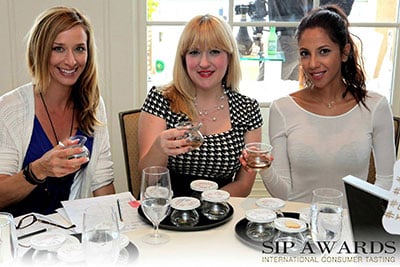
- Male Peer Pressure: Less olfactory-sensitive males don’t mind pungency and clubs are primarily a fraternal male bonding scene with membership signified and validated by using the ritual fraternal tulip icon. Cross-gender peer pressure, “do what we do,” is common with obvious items like the choice of glassware, no doubt contributing to the growing number of “women only” whiskey clubs.
- The Difference: To clarify, at 17 USA country-wide spirits events, we performed 2,914 A-B comparison tests of a glass engineered to divert ethanol versus a tulip containing the same spirit. In summary: 87% males, and 98% of females prefer the engineered glass, with a 97.5% data confidence level. However, at all events we’ve attended, well over 95% of whiskey-drinking males use tulips, the universal signal of recognition, to affirm “Hi, we’re fraternity brothers.” Indeed, nosing quickly turns from science to social.
- Macho Attitudes: During these studies, we perceive widespread macho attitudes (higher proof = manlier) exist regarding ethanol; strikingly similar to attitudes toward hot peppers or tequila shots “Stronger (or more) is better.”
- “Avoid ethanol” drinking procedures solve tulip ethanol problems, or better still, “Who needs ’em anyway?”
- High proof = high quality = better whiskey, cask strength is best, because “It’s so obvious.”
- High pungency means high proof (quality). “Of course, it’s pungent, that’s alcohol! It’s good stuff, man up and drink!”
- High price = high quality (higher proof = higher cost). “I can buy quality by price alone.”
- Whiskey buyers always check proof/ABV first, because “All I need to know is how much alcohol I get for my bucks.”
- Tulip glasses must be scientific, because “If they weren’t, no one would use them.” Tradition = truth.
From the very first tulip sniff, the emphasis is on strong, pungent, olfactory ethanol. It’s not too difficult to understand how misconceptions regarding ethanol become fact in the absence of science or proper education, especially to the majority of drinkers with only a superficial drinking interest, and, consequently, no interest in true whiskey appreciation.
Industry education is a failure: Unhealthy attitudes are never directly addressed, yet without tacit rejection, they become surreptitiously inferred and are assumed through decades of widespread, long-time tulip use which repetitively reinforces pungent ethanol on every nose with every sniff as the expected benchmark of the spirits tasting experience.
Brand ambassadors, spirits industry educators, WSET, and sommelier courses employ tulip glasses to educate, yet do not teach sensory or ethanol’s influence on social group mentality. These discussions consume time, and divert from priorities of buying, selling, and distributing whiskey, and few are willing to risk their reputations by rejecting the accepted tulip norm.
Summary: Sadly, despite its simplicity, the “dock glass” tulip creates and perpetuates more problems than solutions. As our society accepts and even promotes social drinking, it is a shame we continue to leave the true issues unfinished with our “head in the sand” attitude. As a result, social issues prolong, and new generations learn bad habits.
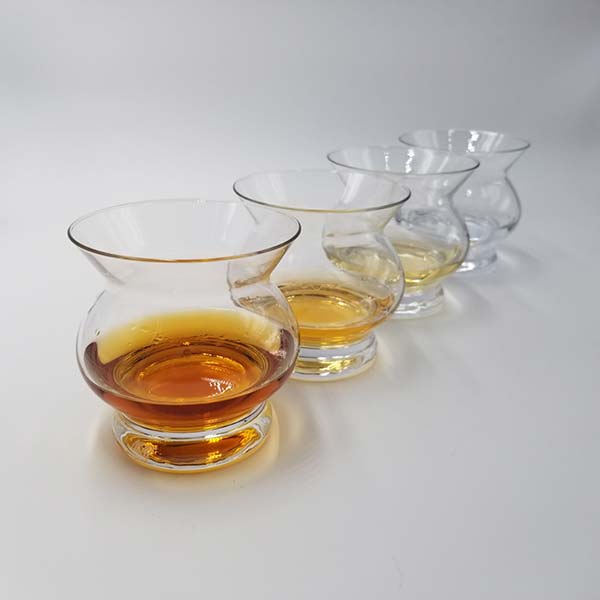
A Possible Solution: A simple sensory-engineered glass design provides an alternative by; (1) enlightening drinkers, distillers, and educators to better quality and a higher level of enjoying spirits, (2) dispelling aberrant social attitudes, (3) supporting gender equity and inclusion, and (4) raising the quality standard, all by reducing up-front olfactory ethanol. In Part 3, Modern Science Changes the Way the World Drinks.
Part 3 – Modern Science Changes the Way the World Drinks
Glass shape controls olfactory perception and may affect social attitudes. At least 20 years of sensory science is ignored by the spirits industry. Application of sensory, physical, and chemical sciences improves spirit drinking enjoyment, consumer perception, and has the potential to improve quality. Despite the science, we are stuck with a non-functional vessel that hides true appreciation of spirits.
Science Addresses Problems Using Tulips: Proper use of the tulip requires much adaptation in drinking procedures (see Part 1) to avoid pungent, nose-numbing ethanol. These procedures are taught by industry executives, brand ambassadors, expert credential certification courses and hospitality college curriculum courses. The Procedure is followed by a scientific rebuttal:
- Don’t swirl. Swirling is the “engine” that powers evaporation. Swirling breaks the surface tension and releases aromas, that’s exactly why wine drinkers swirl. Narrow bowls restrict swirling, narrow rims restrict larger mass molecules from reaching the rim for detection. Wide rims, short height, and fat bowls mean better swirling.
- Breathe through mouth and nose simultaneously. Mouth intake is air only, no spirit aromas; the nose detects aromas. Lower inhale velocities result in lower ethanol on the nose, but also fewer aromas. Without ethanol, inhaling through the nose only with (closed mouth) will maximize olfactory aroma exposure. Close the mouth, and use a glass that does not concentrate ethanol at the nose to get the best experience.
- Add a little water. Most common spirits are 40% ABV (ethanol alcohol by volume). Water and character molecules make up 60% of the spirit volume. Ethanol is the most volatile component and evaporates the quickest. Water has a higher surface tension and shuts down all aroma evaporation, giving the false impression that it “opened up” the spirit because the pungency is gone. Further complicating the issue, blenders add a lot of water (more than 1oz water to 1oz of spirit) to prevent nose numbing and avoid distracting pungency – that high ratio of water changes the spirit’s aroma profile. All because no one will search for a better glass. Despite the failure in logic, drinkers press on.
- Don’t smell ortho-nasally. Although many avoid ortho-nasal to escape pungency with tulips, it does alleviate anxiety by confirming the sample is safe to ingest and also may set expectations for the palate tasting.
- Repeatedly waft aromas toward the nose as glass approaches the nose to acclimate. Wafting or “shaking hands” gradual introduction may acclimate to pungency but does not decrease ethanol olfactory effects, and the sense of smell stealthily continues to degrade with every sniff from tulips without warning. Without question, acclimation does nothing to change the nose numbing, only the pungency. Nevertheless, the practice is widespread.
What Works? These “Crutches” to avoid ethanol pungency would never exist if tulip suitability was questioned early on, but what are the alternatives? Worse than tulips, snifters are the ideal glass for “huffing” ethanol for a quick “high.” The centuries-old open-rim Scottish quaich (pronounced quake), and the Oaxaca gourd cuppa dissipate ethanol well, as do martini and cocktail glasses.
Within traditional glass shapes a large, wide-mouth tumbler is best, and swirls well. The only shape ever scientifically engineered is NEAT, which diverts ethanol and enhances aroma detection, identification, and discrimination.
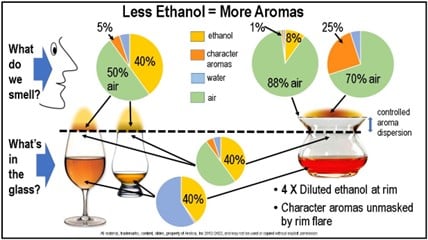
NEAT (Naturally Engineered Aroma Technology) Science: NEAT employs Graham’s Law of Gaseous Diffusion to separate pungent, low-mass ethanol from high-mass character flavor aromas. Passing aromas through an orifice (neck) increases ethanol separation and dispersion. The flared rim controls the dispersion rate. Yellow (ethanol) is bad for the nose, and Orange (character aromas) is good. Other benefits include:
- Wide bowl, engineered to produce better swirling and aroma release
- Rim size places nostrils at rim plane center with lips on rim, avoiding ethanol. No more tiny rim/nose bumps.
- Short height brings the nose closer to the source of evaporation.
- Orifice “neck” forces aroma closer together to create dispersal and separation.
- Large, flared rim controls ethanol dissipation to the rim, greatly reducing pungency, displaying more intense, ethanol-free flavor/character aromas for critical evaluation and identification. No more pungency or nose-burn.
- Blenders no longer have to alter the aroma profile to avoid pungency.
- Elite version includes a heavy base heat sink for improved temperature control and handling.
Weird Shapes Provide Answers: The necessary “hump” in the glass coupled with the wide rim flare can dribble if not mastered (similar to martini glass), a small price to pay for the greater benefit of enjoying neat spirits without pungent, nose-numbing ethanol. Spirits buyers seldom detect subtle differences between the same types of spirits in tulip glasses. With NEAT, aged, rare, and cask-strength spirits are at their best. NEAT is the Official Judging Glass of over 40+ International spirits judging competitions annually. Since 2013, 200,000+ spirits judged, 80,000+ quality medals awarded.
Summary: Industry and consumer benefits are positive and meaningful as NEAT (1) embraces social responsibility and dispels unhealthy attitudes long reinforced by tulips which concentrate ethanol, (2) addresses gender equity, (3) contributes to quality improvement, and (4) raises consumers’ product perception level by unmasking what hides behind ethanol. Time for a cool change. Being a club member has its advantages, and a serious whiskey drinker needs the best diagnostic glass. As a matter of fact, serious whiskey drinkers can be both.

Bio: George F Manska, CR&D, Arsilica, Inc.
Qualifications: Published sensory science researcher, entrepreneur. BSME, NEAT glass co-inventor
Mission: Replace myth and misinformation with scientific truth through consumer education.
Comments Welcome – Contact: george@arsilica.com, phone 702.332.7305.
More Information: www.theneatglass.com/shop

